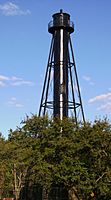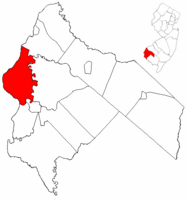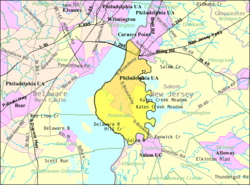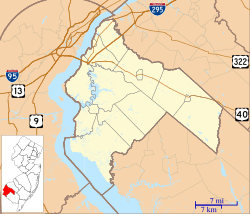Pennsville Township, New Jersey facts for kids
Quick facts for kids
Pennsville Township, New Jersey
|
||
|---|---|---|
|
Township
|
||

Finn's Point Rear Range Light
|
||
|
||

Pennsville Township highlighted in Salem County. Inset map: Salem County highlighted in New Jersey.
|
||

map of Pennsville Township, New Jersey
|
||
| Country | ||
| State | ||
| County | ||
| Formed | July 10, 1721 as Lower Penns Neck Township | |
| Incorporated | February 21, 1798 | |
| Renamed | November 2, 1965 as Pennsville Township | |
| Named for | William Penn | |
| Government | ||
| • Type | Township | |
| • Body | Township Committee | |
| Area | ||
| • Total | 24.58 sq mi (63.66 km2) | |
| • Land | 21.27 sq mi (55.08 km2) | |
| • Water | 3.31 sq mi (8.58 km2) 13.48% | |
| Area rank | 111th of 565 in state 7th of 15 in county |
|
| Elevation | 16 ft (5 m) | |
| Population
(2020)
|
||
| • Total | 12,684 | |
| • Estimate
(2023)
|
12,765 | |
| • Rank | 201st of 565 in state 1st of 15 in county |
|
| • Density | 596.4/sq mi (230.3/km2) | |
| • Density rank | 431st of 565 in state 5th of 15 in county |
|
| Time zone | UTC−05:00 (Eastern (EST)) | |
| • Summer (DST) | UTC−04:00 (Eastern (EDT)) | |
| ZIP Code |
08070
|
|
| Area code(s) | 856 | |
| FIPS code | 3403357870 | |
| GNIS feature ID | 0882134 | |
Pennsville Township is a community located in Salem County, New Jersey. It is named after William Penn, a famous historical figure. Pennsville is special because it's the westernmost town in New Jersey!
In 2020, about 12,684 people lived in Pennsville Township. This number was a bit lower than in 2010. Pennsville is part of South Jersey and the larger Philadelphia area, also known as the Delaware Valley.
Contents
History of Pennsville Township
Early Settlements
Long ago, in the 1600s, the Lenni Lenape Native American tribe lived in this area. They called it "Hoppemense."
In 1638, people from Sweden arrived and built a trading fort called Fort Christina in what is now Wilmington. A few years later, in 1641, the Swedes bought land on the east side of the Delaware River. This is where Pennsville is today. Records from 1671 show that Swedish and Finnish people were already living here.
Fenwick's Colony and William Penn
In 1675, an English Quaker named John Fenwick came to start his own colony in West Jersey. He called his territory Fenwick's Colony. He didn't know that Europeans were already settled along the Delaware River.
The Swedish and Finnish families living there eventually agreed to recognize John Fenwick as the new owner. They signed agreements to keep their land by paying a yearly rent.
John Fenwick faced many challenges. In 1682, he decided to give most of his land rights to William Penn. Fenwick passed away in 1683.
From Penns Neck to Pennsville
In 1701, the area was renamed Penns Neck Township to honor William Penn. Later, on July 10, 1721, Penns Neck was split into two parts: Upper and Lower Penns Neck.
The township officially became a local government in 1798. On November 2, 1965, the community voted to change the name to Pennsville Township.
Pennsville became a popular place for vacations. Two large hotels, The Silver Grove Hotel (built in 1851) and the River View Hotel (built in 1883), attracted many visitors. In 1914, the owner of the Silver Grove Hotel bought the River View Hotel. This led to the creation of Riverview Beach Park. Thousands of people would visit the park by ferry from May to September.
In 1916, the DuPont Company bought the Fenton's Beach resort area and built a dye factory. Later, in 1929, the Deepwater Generating Station was built. A very important bridge, the Delaware Memorial Bridge, opened in 1951. It connects New Jersey and Delaware right near Pennsville.
Geography of Pennsville Township
Pennsville Township covers about 24.58 square miles (63.66 square kilometers). Most of this area is land, but about 3.31 square miles (8.58 square kilometers) is water.
Pennsville is a main community within the township. Other smaller communities in the area include:
- Cedar Crest
- Churchtown
- Central Park
- Deepwater
- Fort Mott
- Glenside
- Harrisonville
- Penn Beach
- Valley Park
The Salem River forms part of the township's eastern and southern borders. Pennsville Township shares borders with other towns in Salem County, such as Carneys Point Township, Elsinboro Township, Mannington Township, and Salem. It also borders a small part of New Castle County, Delaware.
Population and People
| Historical population | |||
|---|---|---|---|
| Census | Pop. | %± | |
| 1810 | 1,163 | — | |
| 1820 | 1,158 | −0.4% | |
| 1830 | 993 | −14.2% | |
| 1840 | 1,219 | 22.8% | |
| 1850 | 1,429 | 17.2% | |
| 1860 | 1,506 | 5.4% | |
| 1870 | 1,472 | −2.3% | |
| 1880 | 1,334 | −9.4% | |
| 1890 | 1,280 | −4.0% | |
| 1900 | 1,424 | 11.3% | |
| 1910 | 1,544 | 8.4% | |
| 1920 | 2,149 | 39.2% | |
| 1930 | 2,933 | 36.5% | |
| 1940 | 5,113 | 74.3% | |
| 1950 | 7,376 | 44.3% | |
| 1960 | 10,417 | 41.2% | |
| 1970 | 13,296 | 27.6% | |
| 1980 | 13,848 | 4.2% | |
| 1990 | 13,794 | −0.4% | |
| 2000 | 13,194 | −4.3% | |
| 2010 | 13,409 | 1.6% | |
| 2020 | 12,684 | −5.4% | |
| 2023 (est.) | 12,765 | −4.8% | |
| Population sources: 1810–2000 1810–1920 1840 1850–1870 1850 1870 1880–1890 1890–1910 1910–1930 1940–2000 2000 2010 2020 |
|||
2010 Census Information
In 2010, there were 13,409 people living in Pennsville Township. There were 5,491 households, which are groups of people living together.
Most of the people (about 94.7%) identified as White. About 1.5% were Black or African American, and 1.4% were Asian. About 3% of the population identified as Hispanic or Latino.
About 21.9% of the people were under 18 years old. About 15.6% were 65 years or older. The average age in Pennsville Township was 41.8 years.
Education in Pennsville
Students in Pennsville Township attend public schools from pre-kindergarten through high school. These schools are part of the Pennsville School District.
As of the 2021–22 school year, the district had about 1,809 students and 167 teachers. This means there were about 10.8 students for every teacher.
The schools in the district include:
- Valley Park Elementary School (pre-kindergarten to 1st grade)
- Central Park Elementary School (2nd to 3rd grade)
- Penn Beach Elementary School (4th to 5th grade)
- Pennsville Middle School (6th to 8th grade)
- Pennsville Memorial High School (9th to 12th grade)
There is also a private school in the area called Guardian Angels Regional School. It serves students from kindergarten to 8th grade and is part of the Roman Catholic Diocese of Camden.
Transportation

Roads and Highways
Pennsville Township has many roads, including county, state, and U.S. highways, as well as interstates and toll roads. Many of these important roads meet in the northern part of the township near Deepwater.
U.S. Route 130 starts in Pennsville. Route 49 also begins here and goes through the center of town. Interstate 295 and U.S. Route 40 both pass through the northern area. These roads connect to the Delaware Memorial Bridge, which links New Jersey to Delaware.
The New Jersey Turnpike also begins in Pennsville Township. Its first goal was to create a road from Pennsville to Woodbridge Township. Even though the Turnpike starts here, its first exit (Exit 1) is actually in the nearby Carneys Point Township. County Road 551 is another major road that goes through the township.
Public Transportation
NJ Transit provides bus services for people in Pennsville. You can take a bus to and from Philadelphia on the 402 route. There are also local bus services on the 468 routes.
Notable People
Many interesting people have connections to Pennsville Township. Here are a few:
- Kenneth A. Black Jr. (1932–2019), a politician who served in the New Jersey government.
- Gene Foster (born 1942), a professional football player for the San Diego Chargers.
- Daniel Garrison (1782–1851), who served in the U.S. House of Representatives.
- Thomas A. Pankok (1931–2022), another politician who served in the New Jersey government.
- Dave Romansky (born 1938), an Olympic race walker.
- Ritch Shydner (born 1951), a writer, producer, and actor.
- Chris Widger (born 1971), a Major League Baseball catcher and World Series Champion.
- Mike Widger (1948–2016), a linebacker who played in the Canadian Football League.
- Norm Willey (1927–2011), a defensive lineman for the Philadelphia Eagles who later taught and coached football at Pennsville Memorial High School.
See also
 In Spanish: Municipio de Pennsville para niños
In Spanish: Municipio de Pennsville para niños





